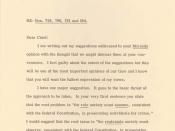In 1963, an 18-year-old woman was kidnapped and raped in Phoenix, Arizona. The police investigated the case, (Miranda vs. the State of Arizona), and arrested Ernesto Miranda, a mentally unstable man. Miranda, who was 23-years-old at the time of his arrest, confessed that he had kidnapped and raped the woman. By confessing to the crime, Miranda was convicted of kidnapping and rape. However, when Miranda was arrested he was not advised of his rights as they are declared in the Fifth Amendment. The Fifth Amendment states, "No person shall be held to answer for a capital, or otherwise infamous crime, unless on a presentment or indictment of a grand jury, except in cases arising in the land or naval forces, or in the militia, when in actual service in time of war or public danger; nor shall any person be subject for the same offense to be twice put in jeopardy of life or limb; nor shall be compelled in any criminal case to be a witness against himself, nor be deprived of life, liberty, or property, without due process of law; nor shall private property be taken for public use, without just compensation."
Simply stated, the Fifth Amendment outlines that anyone (including foreigners) arrested in the United States has certain rights and privileges that should be spelled out for them at the time of the arrest. On appeal, Miranda's lawyers called attention to the fact that the police had never told Miranda that he had the right to be represented by a lawyer, and that he could remain silent if he wished to do so. In addition, Miranda was not told that everything that he said could be used against him. In conclusion, the United State's Supreme Court ruled in favor of the defendant by only a 5 to...



Awsome
This is an excelent essay. Thanks for the help
3 out of 3 people found this comment useful.